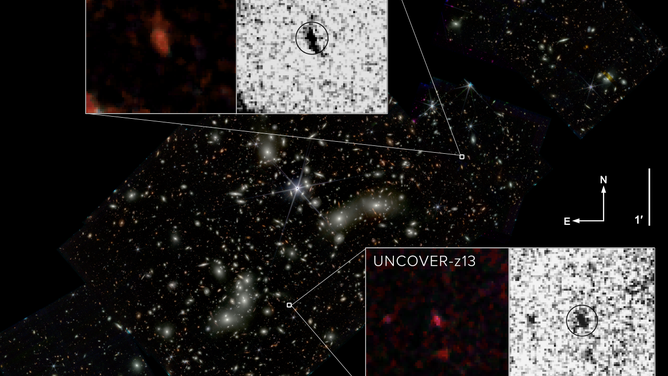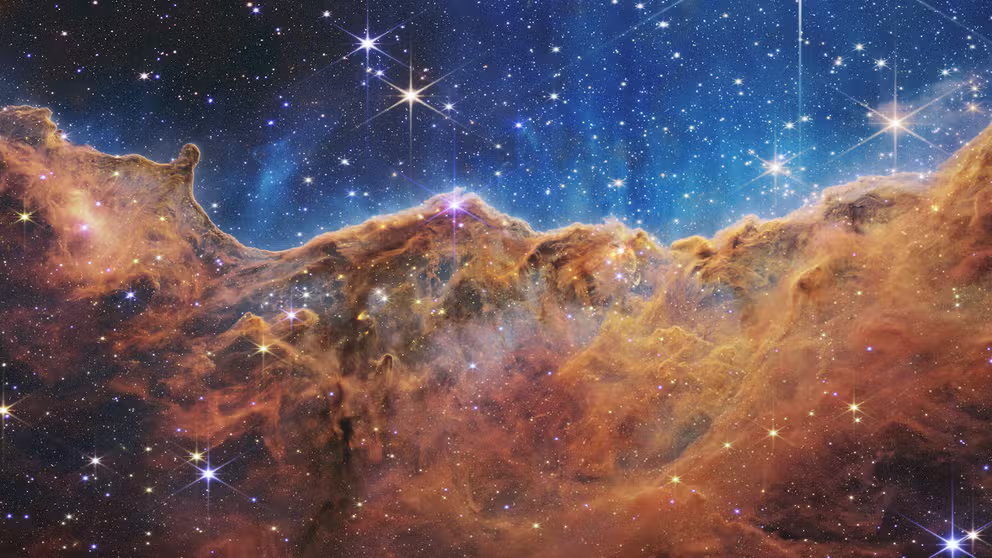Webb Telescope image of Pandora’s Cluster reveals hidden clues of most distant galaxies yet
Two of the galaxies in Pandora's Cluster are nearly 33 billion light years away, the second-and-fourth-farthest galaxies ever observed. Researchers say one galaxy looks like a "peanut" and the other a "fluffy ball" in the JWST images.
Incredible images from James Webb show the universe like never before
As the world's premier space science observatory, the James Webb Space Telescope is giving us glimpses into distant worlds like never before.
Just one image from the powerful James Webb Space Telescope contains hundreds of galaxies and celestial objects, including the image below of an area of the sky known as Pandora's Cluster, where scientists say they have uncovered some of the most distant galaxies ever discovered.
After the initial deep-field image was taken of Pandora's Cluster in 2022 by JWST, an international team led by Penn State researchers took another look at it and confirmed the distance of some of the objects.

This deep field image from NASA’s James Webb Space Telescope features never-before-seen details in a region of space known as Pandora’s Cluster.
(NASA, ESA, CSA)
According to a study published Monday in Astrophysical Journal Letters, two galaxies, at nearly 33 billion light years away, are the second-and-fourth-farthest galaxies ever observed. Before this revelation, only three other galaxies had been confirmed at these far-flung distances in the universe.
The James Webb Space Telescope image of Pandora's Cluster contains about 60,000 light sources. The team of astronomers narrowed the points of interest to 700 before following up on eight candidates they thought could be among the first galaxies.
TELESCOPE USED TO STUDY MYSTERIES OF THE UNIVERSE RELEASES FIRST IMAGES IN STUNNING DETAIL
Study author and Penn State postdoctoral scholar Bingjie Wang said these two galaxies are different from other galaxies at extreme distances because of their appearance.
"Previously discovered galaxies at these distances are point sources — they appear as a dot in our images," Wang said. "But one of ours appears elongated, almost like a peanut, and the other looks like a fluffy ball. It is unclear if the difference in size is due to how the stars formed or what happened to them after they formed, but the diversity in the galaxy properties is really interesting. These early galaxies are expected to have formed out of similar materials, but already they are showing signs of being very different than one another."
After using JWST to look at the smaller pool of galaxies, the telescope recorded the amount of light given off by each galaxy, also known as spectra.

The second- and fourth-most distant galaxies ever seen (UNCOVER z-13 and UNCOVER z-12) have been confirmed using the James Webb Space Telescope’s Near-Infrared Camera (NIRCam). The galaxies are located in Pandora’s Cluster (Abell 2744), show here as near-infrared wavelengths of light that have been translated to visible-light colors. The scale of the main cluster image is labeled in arcseconds, which is a measure of angular distance in the sky. The circles on the black-and-white images, showing the galaxies in the NIRCam-F277W filter band onboard JWST, indicate an aperture size of 0.32 arcsec.
(Cluster image: NASA, UNCOVER (Bezanson et al., DIO: 10.48550/arXiv.2212.04026) Insets: NASA, UNCOVER (Wang et al., 2023) Composition: Dani Zemba/Penn State / NASA)
"The research team estimates that the light detected by JWST was emitted by the two galaxies when the universe was about 330 million years old and traveled for about 13.4 billion light years to reach the JWST," according to a news release.
WEBB TELESCOPE FINDS NEW COLOSSEUM-SIZED ASTEROID IN MAIN BELT BY ACCIDENT
According to the researchers, with the expansion of the universe over time, the galaxies are likely closer to 33 billion light years away from Earth.
"These early galaxies are like beacons, with light bursting through the very thin hydrogen gas that made up the early universe," said Joel Leja, assistant professor of astronomy and astrophysics at Penn State. "It is only by their light that we can begin to understand the exotic physics that governed the galaxy near the cosmic dawn."
The study authors say these ancient galaxies could offer clues as to how the first galaxies formed.
